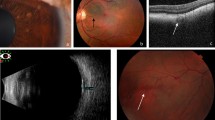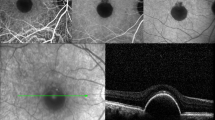Abstract ·
Purpose: To determine in vivo lipofuscin (LF)-induced topographic variations of fundus autofluorescence in eyes with geographic atrophy (GA) of the retinal pigment epithelium (RPE) associated with age-related macular degeneration (ARMD). · Methods: Fundus autofluorescence was examined with a confocal scanning laser ophthalmoscope (Heidelberg Retina Angiograph) after excitation with an argon laser (488 nm) and detection of the emitted light above 500 nm. Fifty-seven eyes of 38 patients with uni- or multifocal GA associated with ARMD were studied. The findings were compared with 43 eyes with GA secondary to other etiologies, including juvenile macular dystrophies. · Results: An increased autofluorescence outside the GA was observed in 47 (82.5%) of 57 eyes with GA associated with ARMD in contrast to 4 (9.3%) of 43 eyes with GA of other causes (P<0.001). Three different patterns were noted: a continuous band at the margin with variable peripheral extension in 36 eyes (76.6%), a diffusely increased autofluorescence at the entire posterior pole in 6 eyes (12.8%), and small focal spots of increased autofluorescence in the junctional zone in 3 eyes (6.4%). Of 19 patients with bilateral GA, 17 (89.5%) had an identical pattern in both eyes. · Conclusions: The different patterns of autofluorescence in the presence of GA associated with ARMD may reflect variable forms of reactive changes in the surrounding RPE cells, and may indicate the extend of compromised RPE secondary to ageing changes in the outer retina, Bruch’s membrane and choriocapillaris. Since GA spreads over time, increased LF accumulation in the junctional zone may precede cell death and may, therefore, be of prognostic value. Knowledge of the topographic variation in LF accumulation is important because heterogeneity may reflect underlying differences in cell kinetics, metabolism and biochemistry.
Similar content being viewed by others
Author information
Authors and Affiliations
Additional information
Received: 27 February 1998 Revised version received: 8 April 1998 Accepted: 20 April 1998
Rights and permissions
About this article
Cite this article
Holz, F., Bellmann, C., Margaritidis, M. et al. Patterns of increased in vivo fundus autofluorescence in the junctional zone of geographic atrophy of the retinal pigment epithelium associated with age-related macular degeneration. Graefe's Arch Clin Exp Ophthalmol 237, 145–152 (1999). https://doi.org/10.1007/s004170050209
Issue Date:
DOI: https://doi.org/10.1007/s004170050209




